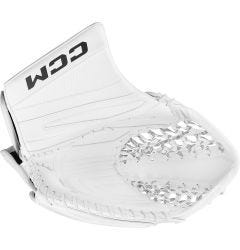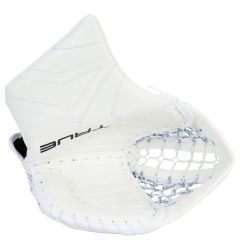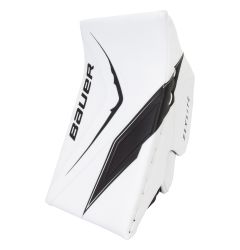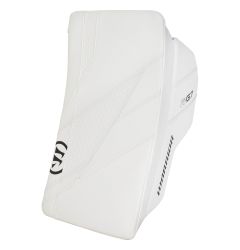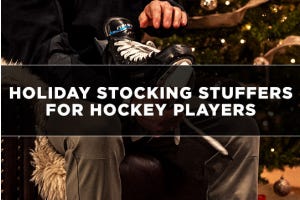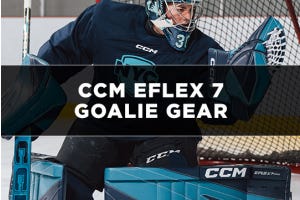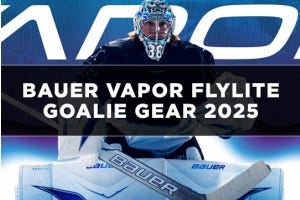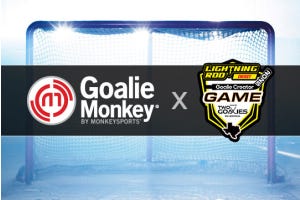Equipment Sizing Information
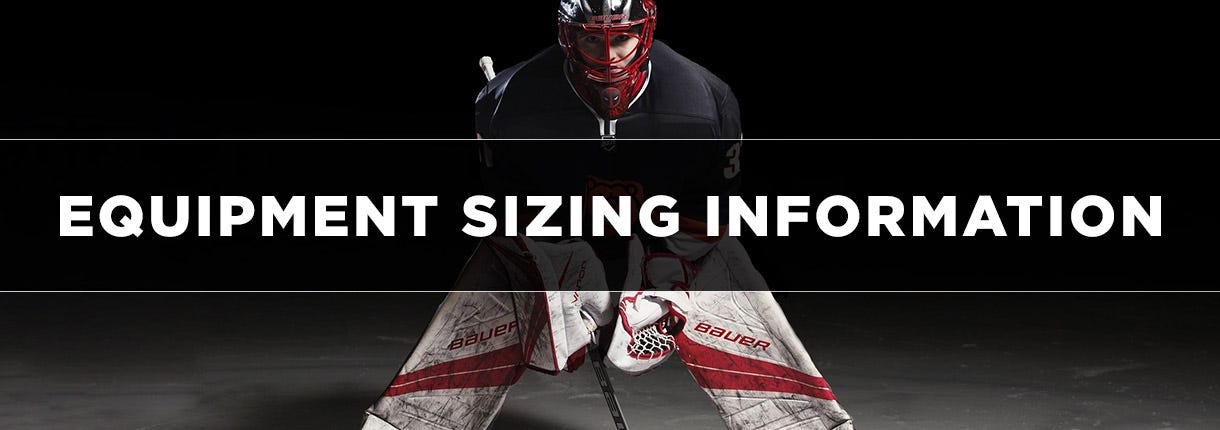
Equipment = Confidence
Goaltending is a unique and challenging position, the most important on the ice. Each goaltender has specific needs because of the way they react or play different situations. In order to play at the top of your game, you must have confidence in your equipment to perform and protect. Equipment confidence is a state of mind, which greatly affects a goaltender's movements. A goaltender without equipment confidence feels unsafe and hesitates before making a move. Aside from selecting the right model of equipment for the level of play, the fit of the equipment is paramount. Purchasing equipment too large or too small will only limit the products ability to perform and protect. Equipment that does not fit properly will never break in properly.
Jump to sizing guides for:
Care & Maintenance
Once you have selected the proper fitting model of equipment that enhances your style and is suitable to your level of play, you should ensure proper care and maintenance. Drying your equipment after use prevents mildew and excessive and premature wear. No product should be used if damaged. Any cuts or tears should be repaired immediately. Old or worn equipment should be replaced to ensure maximum performance and protection. Finally, do not treat synthetic materials with silicone or other water repellents.
The following fitting guide is to be used as a guideline only and may not reflect your personal preference. If you are unsure about the sizing of the equipment you would like to purchase, please call our professional staff of goaltenders for additional information at 1-888-945-4295.
The key factor with Goal Pad Sizing is the overall length. The length is divided into three segments: (A) The Boot, (B) Instep to the Knee, & (C) Knee to top or thigh rise. The proper length of the goal pad boot is determined by the goalie skate size. The next key area is the instep to knee that determines the shin length. Finally, the knee to top or thigh rise is a personal measurement depending on how much pant and pad overlap the goaltender prefers. A general standard is 7" to 8".
Custom Pad Sizing
A. Skate Size: Provide the skate size for proper boot fit
B. Instep to Knee: Measure from instep to the front center of kneecap while the leg is in a slightly bent position
C. Thigh Rise: Measure from front center of kneecap up the thigh to desired height
A + B + C = estimated size of leg pad
If fitted properly, the goalie's knee should rest directly behind the center knee roll with the pad securely attached to the goal skates and properly strapped on the goaltender's leg. Generally, this will ensure that the pad breaks (bends) at the knee / shin and ankle as designed for optimal performance. Consumers are advised to bring their skates and goal pants when going to purchase leg pads. By bringing your skates this will provide for a true fit, as you don't play the game in street shoes, while replicating the actual feel of the pads. Therefore, there are no surprises when the goaltender goes on the ice for the first time.
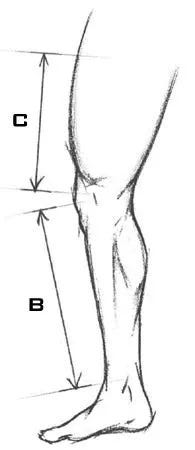

Hockey Goalie Glove Fitting Guide
Although the trend at all levels is to use oversized gloves, the goalie's fingers should extend out to the end of the finger stalls of the inside palm to ensure a proper fit. However, any more than 1/4" from the tip of the goaltender's finger to the end of the finger stalls and the goaltender will not have the proper amount of leverage necessary to close and control the glove. Aside from the lack of control, the glove will also have a tendency to "break back" or fold, which will make the glove difficult to use. The second key factor is that the heel of your hand should line up with the heel and the cuff of the glove. If not, the proper balance between the cuff and the catching portion of the glove may be disturbed, making the glove too cumbersome while sacrificing protection.
Note: 'Regular' Catch Glove = Glove goes on the left hand.
Note: 'Full Right' Catch Glove = Glove goes on the right hand.
Hockey Goalie Blocker Fitting Guide
The blocker should be fitted based on the hand size. The goalie's fingers should be no more than 1/4" from the end of the fingers in the palm. If the fingers are too long, chances are the hand tabs that secure to the blocker are too large. This will cause the blocker to wobble, tilt or rotate on the goaltender's hand, seriously affecting control while limiting coverage.
Note: 'Regular' Blocker = Blocker is on the right hand (also side goalie stick is held).
Note: 'Full Right' Blocker = Blocker is on the left hand (also side goalie stick is held).
Hockey Goalie Pant Fitting Guide
When fitted properly, goal pants should provide unrestricted movement and the crouch position, but should not be so loose that they rotate excessively around the waist. Loosely fitting pants provide superior net coverage in addition to making the goalie look bigger. Goal pants should provide overlapping coverage with the bottom of the chest protector and the tops of the goal pads. You may want to consider using suspenders if the belt isn't enough to keep the pants from dropping.
Goalie Skates Fitting Guide
Ice skate sizing is not necessarily the same as if you were buying a dress shoe or a sneaker. A men's 9 skate does not equal a men's 9 shoe. All skates are sized in Canadian sizes; which are equal to 1 1/2 sizes larger in U.S. shoe size (i.e. a men's U.S. shoe size of 9 is equal to a Canadian size of 7.5). A lot of our customers a say "I could never fit into a 7.5 shoe!" This is true, however, a 7.5 skate is not a 7.5 shoe. Typically your skate size will be 1 to 1.5 skate sizes down from your shoe size. When you receive your skates, try them on and push your foot forward so that your toes (while flat) barely glance the toe cap. Bend your knee forward and look behind the heel of your foot down the skate. If you can fit a finger behind the heel easily the skates are too big. A finger should be wedged securely between the heel of your foot and the back side of the skate. Another way to find your skate size (not width), is to remove the footbed from the skates and stand on it with your knee slightly bent.
Note: Make sure not to sharpen your skates until you are certain you have the correct size, sharpened skates cannot be returned.
| Goalie Skate Sizing Chart | |||||||||||||
|---|---|---|---|---|---|---|---|---|---|---|---|---|---|
| Skate Size | 6.0 | 6.5 | 7.0 | 7.5 | 8.0 | 8.5 | 9.0 | 9.5 | 10.0 | 10.5 | 11.0 | 11.5 | 12.0 |
| US Men's Shoe Size | 7.5 | 8.0 | 8.5 | 9.0 | 9.5 | 10.0 | 10.5 | 11.0 | 11.5 | 12.0 | 12.5 | 13.0 | 13.5 |
| EUR Shoe Size | 40.5 | 41.0 | 42.0 | 42.5 | 43.0 | 44.0 | 44.5 | 45.0 | 45.5 | 46.0 | 47.0 | 47.5 | 48.0 |
| UK Men's Shoe Size | 6.5 | 7.0 | 7.5 | 8.0 | 8.5 | 9.0 | 9.5 | 10.0 | 10.5 | 11.0 | 11.5 | 12.0 | 12.5 |
| Actual Shoe Size as determined by a Branock Shoe Sizing Device. Sizing will vary by manufacturer. | |||||||||||||
For a complete sizing guide for hockey skates, refer to our hockey skate sizing guide.
Goalie Stick Fitting Guide
There are several factors that should play into selecting a goalie stick. The goalie’s height and more importantly, personal preference, should be considered in selecting the correct paddle length. Although there is no direct correlation between the goalie’s height and paddle length, goalies should usually start using a senior sized stick at about 5’5”.
Goalie Stick Length Chart
| Age Group | Height | Stick Length |
|---|---|---|
| Youth (3-5) | 3'0" - 3'10" | 38" - 44" |
| Youth (6-8) | 3'10" - 4'8" | 45" - 49" |
| Junior (7-13) | 4'4" - 5'1" | 50" - 54" |
| Intermediate (11-14) | 4'11" - 5'4" | 55" - 58" |
| Intermediate (12-14) | 5'2" - 5'8" | 55" - 58" |
| Senior (14+) | 5'5" - 5'10" | 57" - 61" |
| Senior (14+) | 5'7" - 6'1" | 58 - 62" |
| Senior (14+) | 5'10" - 6'4" | 60" - 63" |
| Senior (14+) | 6'1" + | 60" - 63" |
For a complete sizing guide for hockey sticks, refer to our hockey stick sizing guide.
Tips for Hockey Players, Parents and Coaches
- Regularly check and update equipment as the player grows.
- Consider the player's comfort and mobility when sizing equipment.
- Consult with experienced coaches for additional guidance.
Conclusion
Properly sized hockey equipment is a game-changer, affecting both performance and safety on the ice. Utilize the guidelines and sizing chart provided in this comprehensive guide to ensure you find the perfect fit for every piece of equipment. Remember, a well-fitted player is a confident player, ready to face the challenges of the game head-on.
By prioritizing hockey equipment sizing, you're not only investing in your game but also safeguarding your well-being for an enjoyable and injury-free hockey experience.
FAQs on Hockey Equipment Sizing
There are several factors that should play into selecting a goalie stick. The goalie’s height and more importantly, personal preference, should be considered in selecting the correct paddle length. Although there is no direct correlation between the goalie’s height and paddle length, goalies should usually start using a senior sized stick at about 5’5”.
Can I use the same size for all hockey brands?
Sizing may vary between brands, so it's essential to refer to the specific sizing charts provided by each manufacturer for accurate measurements.
Can I buy hockey equipment online without trying it on first?
While online shopping is common, it's recommended to visit a local store to try on equipment and ensure the right fit before making a purchase.
Can I mix and match brands for different pieces of hockey equipment?
While it's possible, it's advisable to stick with one brand for a consistent fit. Different brands may have variations in sizing and design.
Can I wear additional layers under my hockey gear for warmth?
Yes, wearing moisture-wicking base layers for warmth is common. However, ensure they don't compromise the snug fit of your protective gear.
Note: Due to varying individual body types and measurements, the sizing charts and information provided on this website are to be used as guidelines. If you have any questions on sizing, please call us at (888) 945-4295 and speak to our knowledgeable goalie representatives to help you choose the correct size for your equipment.




